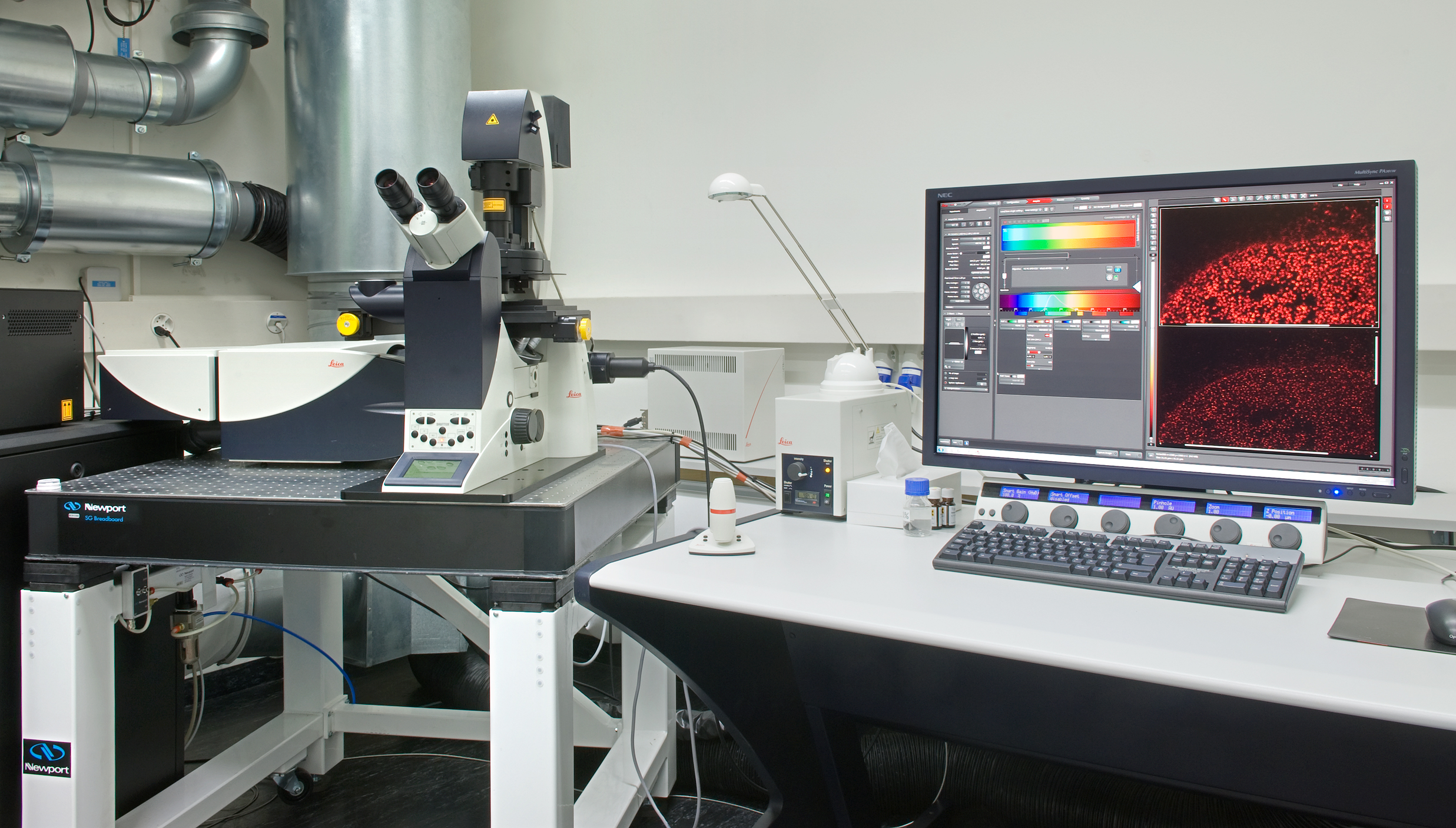CLSM - Leica SP8 inverse STED 3X (Irchel)
The gSTED super-resolution microscope is based on a Leica SP8 inverted confocal microscope outfitted with a very flexible white light laser source and additional depletion laser lines. This allows using the STED (STimulated Emission Depletion) principle to perform imaging beyond the diffraction limit. Under optimal conditions a resolution of 50 nm laterally (xy) and 130 nm axially (z) can be achieved. In contrast to other super-resolution techniques, STED microscopy can directly be applied to samples suitable for standard confocal microscopy. This also includes imaging living cells.
Location
University Zurich, Irchel Campus, Room Y42-H-81.
Training Request
Follow this link to apply for an introduction to the microscope.
Technical Specifications
Microscope
- inverted confocal microscope (Leica DMI6000B, Model SP8)
- 5 freely selectable emission detection windows
- motorized x/y stage
- 3D capability (confocal, STED)
- time lapse capability
Light Sources and Lasers
- Halogen lamp for transmitted light
- External fluorescence lamp LQ-HXP 120
- Diode laser 405 nm (50mW)
- White light laser (WLL): continuous laser output in the range of 470-670nm; AOTF allows to choose up to 8 different wavelengths simultaneously; pulsed laser system with a repetition rate of 80 MHz
- Continuous wave depletion lasers at 592 nm and 660 nm
- Pulsed depletion laser at 775 nm
Scanners (tandem scanner system)
- confocal point-scanning - optical sectioning
- zoom function
- Regular scanner (field-of-view scanner): 1 Hz to 1800 Hz
- Resonant scanner: 12 kHz
Detectors
- 5 confocal fluorescence channels: three Photomultipliertubes (PMTs) and two super-sensitive Hybrid detectors (HyD, suitable for time gated detection)
- one transmission light-channel (PMT-Trans)
- time gated single photon detection with the two HyD detectors: allows to improve the STED resolution using the time domain (gated STED) as well as for suppression of short lived effects such as scattering of excitation light
Objectives
| Name | Magnification | NA | Immersion | WD (mm) |
|---|---|---|---|---|
| HCX PL FLUOTAR | 10x | 0.3 | Air | 11.0 |
| HC PL APO CS2 | 20x | 0.75 | IMM | 0.68 |
| HC PL APO CS2 | 63x | 1.4 | oil | 0.14 |
| HC PL APO STED WHITE - motCORR | 93x | 1.3 | glycerol | 0.3 |
| HC PL APO STED WHITE | 100x | 1.4 | oil | 0.1 |
CS2 objectives: improved color correction, perfect VIS-405; WHITE: optimal color correction for full spectrum; IMM = multi immersion (either water, glycerol or oil)
Fluorescence Filters
| Name | Excitation Range | Excitation Filter | Dichroic | Emission Filter |
|---|---|---|---|---|
| A4 | UV | BP 360/40 | 400 | BP 470/40 |
| I3 | blue | BP 470/40 | 510 | LP 515 |
| N2.1 | green | BP 515-560 | 580 | LP 590 |
| CFP/YFP | violet/blue | BP 436/12; 500/20 | 445; 515 | BP 467/37; 545/45 |
Accessories
- controlled environmental conditions (CO2, temperature, humidity)
- Ludin chambers for 12 mm and 18 mm coverslips (reservation needed)
- Matrix screening software (reservation needed)
Make sure to acknowledge the Center for Microscopy in your publication to support us.
How to acknowledge contributions of the Center for Microscopy
Remarks
Using a depletion laser is an obligate requirement for performing STED super-resolution imaging. Choosing the appropriate dyes or fluorescent proteins suitable for depletion by one of the different depletion lasers is crucial for performing successful STED experiments. We highly encourage you to contact us for suitable candidates before starting your experiment.
Literature and Links
Further information (internal UZH use only)
Follow this link for further background information, documents and links.
Responsible Persons
If you have questions about the device please contact the responsible person.
Make sure to acknowledge the Center for Microscopy in your publication to support us.
How to acknowledge contributions of the Center for Microscopy
